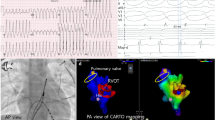Abstract
Radiofrequency (RF) catheter ablation has ushered in a new era in the management of patients with symptomatic tachyarrhythmias. By providing the ability to cure the underlying arrhythmic substrate, RF catheter ablation obviates the need for life-long antiarrhythmic drugs. In the reported series, the success has been high and the complications have been infrequent and relatively minor. Not unexpectedly, RF catheter ablation has become the treatment of choice for patients with symptomatic paroxysmal tachyarrhythmias. The role of radiofrequency catheter ablation in infants and small children remains controversial, and awaits a larger experience and longer follow-up data.
Similar content being viewed by others
References
Jackman WM, Wang XZ, Friday KJet al. Catheter ablation of accessory atrioventricular pathways (Wolff-Parkinson-White Syndrom) by radiofrequency currentN Engl J Med 1991, 324: 1605–1611.
Calkins H, Langberg J, Sousa Jet al. Radiofrequency catheter abation of accessory atrioventricular connections in 250 patients. Abbreviated therapeutic approach to Wolff-Parkinson-White Syndrome.Circulation 1992; 85: 1337–1346.
Jackman WM, Beckman KJ, McClelland JHet al. Treatment of supraventricular tachycardia due to atrioventricular nodal reentry by radiofrequency catheter ablation of slow pathway conduction.N Engl J Med 1991; 327: 313–318.
Kugler JD, Danford DA, Deal BJet al. Radiofrequency catheter ablation for tachyarrhythmias in children and adolescents.N Engl J Med 1994; 330: 1481–1487.
VanHare GF, Witherell CL, Lesch MD. Follow-up of radiofrequency catheter ablation in children: results in 100 consecutive patients.J Am Coll Cordial 1994; 23: 1651–1659.
Sreeram N, Sneets JLRM, Pulles-Heintzberger CFM, Wellens HJJ. Radiofrequency catheter ablation of accessory atrioventricular pathways in children and young adult.Br Heart J 1993; 70: 160–165.
Dhala A, Bremner S, Deshpande Set al. Efficacy and safety of atrioventricular nodule modification for atriventricular nodule reentrant tachycardia in the pediatric population.Am Heart J 1994; 128: 903–907.
Kugler JD. Radiofrequency catheter ablation for supraventricular tachycardia. Should it be used in infants and small children.Circulation 1994; 90: 639–641.
Avitall B, Khan M, Krum D et al. Physics and engineering of transcatheter cardiac tissue ablation.J Am Coll Cardiol 1993; 22: 921–932.
Friedman JK, Saul JP, Weindling SN, Walsch EP. Radiofrequency ablation of inter-atrial reentrant tachycardia after surgical palliation of congenital heart disease.Circulation 1995; 91; 707–714.
Park JK, Halperin BD, Mc Amulty JHet al. Comparison of radiofrequency catheter ablation procedures in children, adolescents and adults and the imact of accessory pathway location.Am J Cardiol 1994; 74: 786–789.
Green TO, Huang SKS, Wagshal ABet al. Cardiovascular complications after radiofrequency catheter ablation of supraventricular tachyarrhythmias.Am J Cardiol 1994; 74: 615–617.
Thakur PK, Klein GJ, Yee R, Zardini M. Embolic complications after radiofrequency catheter ablation.Am J. Cardiol 1994; 74: 278–279.
Lau YR, Case CL, Gillette PCel al. Frequency of atrioventricular valve dysfunction after radiofrequency catheter ablation via the atrial approach in children.Am J Cardiol 1994; 74: 617–619.
Calkins H, Niklason L, Sousa Jet al. Radiation exposure during radiofrequency catheter ablation of accessory atrioventricular connections.Circulation 1991, 84; 84: 2376–2382.
Perry JC, Garson A Supraventricular tachycardia due to Volff Parkinson-White syndrome in children: early disappearance and late recurrence,J Am Coll Cardiol 1990; 16: 1215–1220.
Deal BJ, Keane JF, Gillette PC, Garson A Wolff-Parkinson-White Syndrome and supraventricular tachycardia during infancy: management and follow-up.JAm Coll Cardiol 1985; 5: 130–135.
Mehta AV, Sanchez CR, Acks EJet nl.Ectopic atrial tachycardia in children: clinical characteristics, management and follow-up.J Am Coll Cardiol 1988; 11: 379–385.
Saul JP, Hulse JE, Papagiannis Jct al Late enlargement of radiofrequency lessons in infant lambs. Implications for ablation procedures in small children.Circulation 1994; 90: 492–499.
Author information
Authors and Affiliations
Rights and permissions
About this article
Cite this article
Bhandari, A.K. Radiofrequency ablation in children. Indian J Pediatr 63, 609–613 (1996). https://doi.org/10.1007/BF02730803
Issue Date:
DOI: https://doi.org/10.1007/BF02730803




